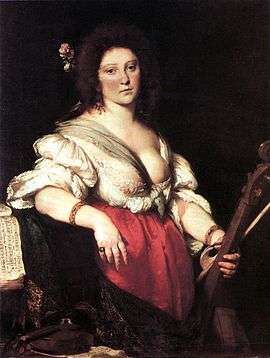Barbara Strozzi

Barbara Strozzi (also called Barbara Valle; baptised 6 August 1619 – 11 November 1677) was an Italian singer and composer. Her Baroque compositions were published in her lifetime.
Biography
Giulio Strozzi, a poet and librettist,[1] recognised Barbara as his adopted daughter. She was most likely the illegitimate daughter of Strozzi and Isabella Garzoni, his long-time servant and heir. She was baptised in the church of Santa Sofia in the Cannaregio district (sestiere) of Venice.
Giulio encouraged his daughter's musical talent, even creating an academy in which Barbara’s performances could be validated and displayed publicly. He seemed to be interested in exhibiting her considerable vocal talents to a wider audience.[2] However, her singing was not her only talent. She was also compositionally gifted, and her father arranged for her to study with composer Francesco Cavalli.
It is conceivable that Strozzi may have been a courtesan, although she may have merely been the target of jealous slander by her male contemporaries.[2] She appears to have led a quiet, if not slightly unusual life; there is evidence that at least three of her four children were fathered by the same man, Giovanni Paolo Vidman (also spelled Widmann). He was a patron of the arts and supporter of early opera. After Vidman's death it is likely that Strozzi supported herself by means of her investments and by her compositions. He did not, apparently, leave anything to her or her children in his will.[3]
Strozzi died in Padua in 1677 aged 58. She is believed to have been buried at Eremitani.[4] When she died without leaving a will, her son Giulio Pietro claimed her inheritance in full.[5]
Music
Strozzi was said to be "the most prolific composer – man or woman – of printed secular vocal music in Venice in the Middle of the century."[6] Her output is also unique in that it only contains secular vocal music, with the exception of one volume of sacred songs.[7] She was renowned for her poetic ability as well as her compositional talent. Her lyrics were often poetic and well-articulated.[3]
Nearly three-quarters of her printed works were written for soprano, but she also published works for other voices.[8] Her compositions are firmly rooted in the seconda pratica tradition. Strozzi’s music evokes the spirit of Cavalli, heir of Monteverdi. However, her style is more lyrical, and more dependent on sheer vocal sound.[9] Many of the texts for her early pieces were written by her father Giulio. Later texts were written by her father's colleagues, and for many compositions she may have written her own texts.
Publications
- Il primo libro di madrigali, per 2–5 voci e basso continuo, op. 1 (1644)
- Cantate, ariette e duetti, per 2 voci e basso continuo, op. 2 (1651)
- Cantate e ariette, per 1–3 voci e basso continuo, op. 3 (1654)
- Sacri musicali affetti, libro I, op. 5 (1655)
- Quis dabit mihi, mottetto per 3 voci (1656)
- Ariette a voce sola, op. 6 (1657)
- Diporti di Euterpe ovvero Cantate e ariette a voce sola, op. 7 (1659)
- Arie a voce sola, op. 8 (1664)
References
- ↑ Giulio Strozzi
- 1 2 Glixon 1997.
- 1 2 Glixon 1999, p. 138.
- ↑ Glixon 1999.
- ↑ Glixon 1999, p. 141.
- ↑ Glixon 1999, p. 135.
- ↑ Heller 2006.
- ↑ Kendrick 2002.
- ↑ Rosand 1986, p. 170.
Sources
- Glixon, Beth L. (1997). "New light on the life and career of Barbara Strozzi". The Musical Quarterly. 81 (2): 311–335. doi:10.1093/mq/81.2.311.
- Glixon, Beth L. (1999). "More on the life and death of Barbara Strozzi". The Musical Quarterly. 83 (1): 134–141. doi:10.1093/mq/83.1.134.
- Heller, Wendy (2006). "Usurping the place of the muses: Barbara Strozzi and the female composer in seventeenth-century Italy". In Stauffer, George B. The World of Baroque Music: New Perspectives. Bloomington: Indiana University Press. pp. 145–168. ISBN 978-025334798-5.
- Kendrick, Robert (2002). "Intent and intertextuality in Barbara Strozzi's sacred music". Recercare. Rivista per lo Studio e la Practica della Musica Antica. 14: 65–98. JSTOR 41701379.
- Rosand, Ellen (1986). "The voice of Barbara Strozzi". In Bowers, Jane; Tick, Judith. Women Making Music: the Western art tradition, 1150-1950. Urbana, Illinois: University of Illinois Press. pp. 168–190. ISBN 978-025201204-4.
Further reading
- Ellen Rosand with Beth L. Glixon. "Barbara Strozzi", Grove Music Online, ed. L. Macy (grovemusic.com (subscription required).
- Magner, Candace A. (2002). "Barbara Strozzi: a documentary perspective", The Journal of Singing, 58/5.
- Mardinly, Susan J. (2002). "Barbara Strozzi: from madrigal to cantata", Journal of Singing, 58 (5) 375-391.
- Mardinly, Susan J. (2009). "A View of Barbara Strozzi", International Alliance for Women in Music Journal, 15 (2).
- Mardinly, Susan (2004). "Barbara Strozzi and the pleasures of Euterpe", PhD Diss., University of Connecticut, 2004.
- Rosand, Ellen (1978). "Barbara Strozzi, virtuosissima cantatrice: the composer’s voice", Journal of the American Musicological Society, 31, (2) 241–281.
- Schulenberg, David (2001). "Barbara Strozzi" Music of the Baroque, Oxford: Oxford University Press. pp. 110-115.
External links
| Wikimedia Commons has media related to Barbara Strozzi. |